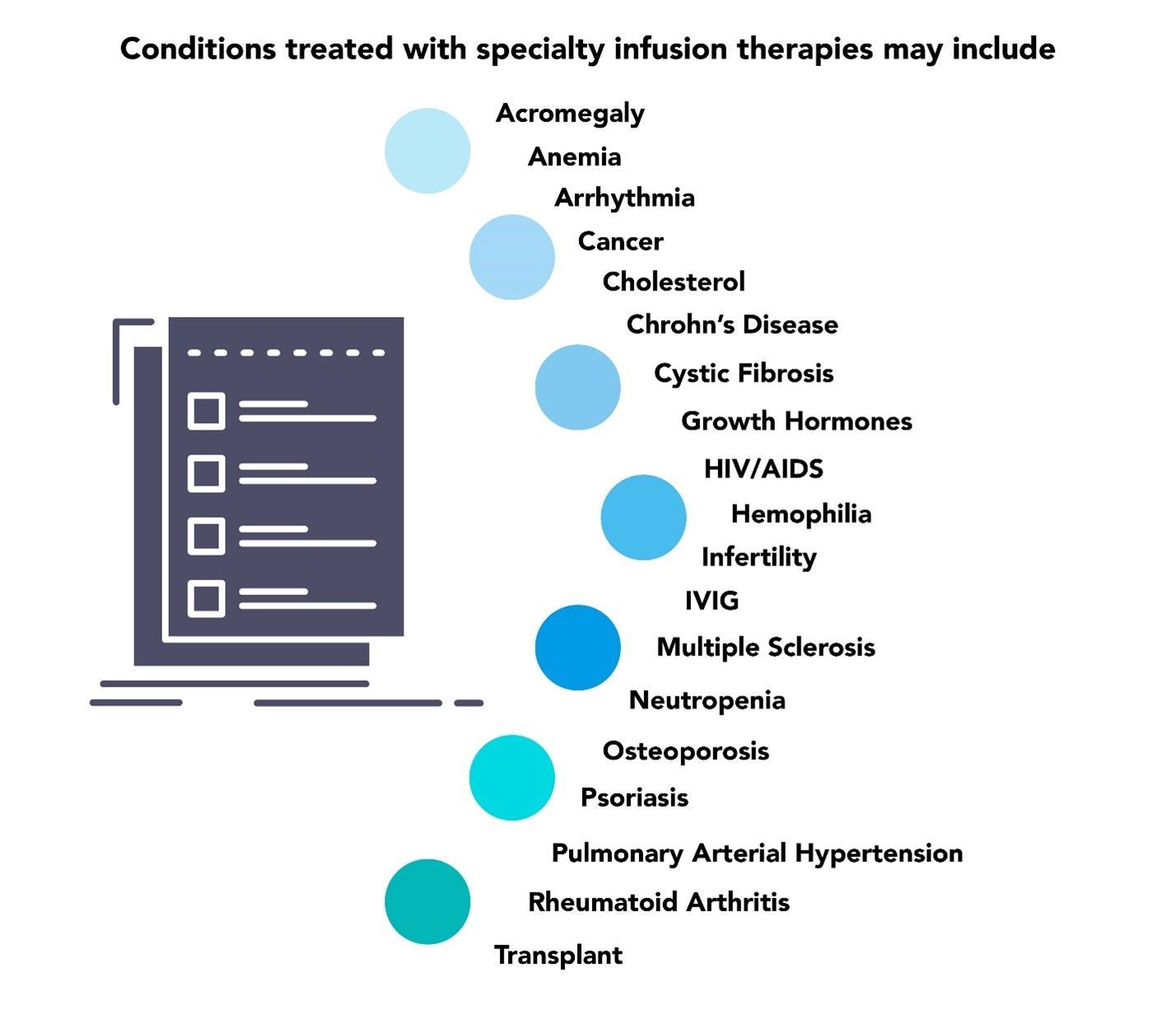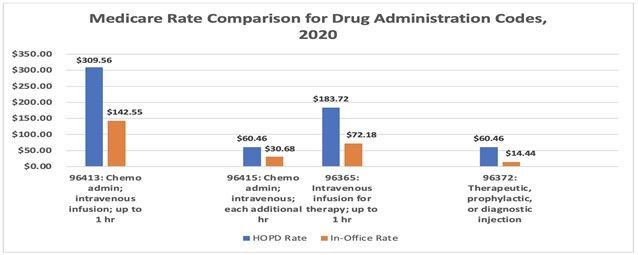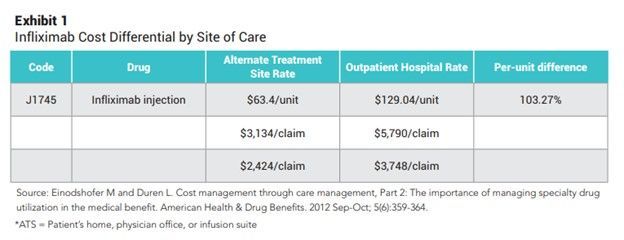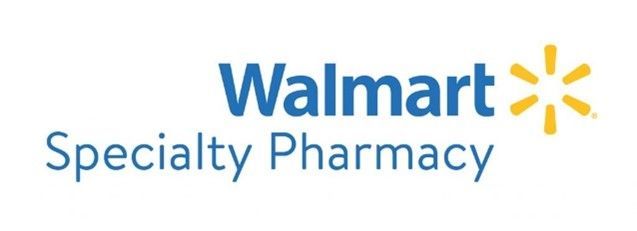
Location Matters: Optimizing Site of Care for Infusion Therapy
Site of Care (SOC) Optimization is a top proven strategy.

Site of Care (SOC) Optimization is one of the top proven strategies for reducing the cost of specialty biologic medications. These powerful specialty drugs, which often represent the cutting-edge of biomedical research, may offer the most effective means to treat a variety of medical illnesses and conditions that presently have no other treatments available.
Optimizing site selection for the infusion of biologics is an approach that encourages patients to move from higher-cost settings, like big hospitals and institutions that add on a facility fee, to clinically appropriate, high quality lower-cost settings, such as stand-alone infusion centers. This is clearly the most common-sense, win-win model for rapidly lowering the cost of delivering specialty biologics.

Source: www.infusioncenter.org*
Home Infusion: Convenient and Cost-Effective for Patients
One study found that, compared to medical setting infusion patients, home infusion patients were no more likely to have adverse drug events or side effects. What’s more, clinical outcomes were as good if not better. For example, patients with hemophilia had a 40% reduction in the likelihood of hospitalization for bleeding complications. Patients also overwhelmingly preferred home infusion and reported greater physical and mental well-being, as well as less disruption to daily life and reduction in burden for caregivers. In addition, home infusion costs were significantly lower than medical setting infusion costs, with savings between $1,928 and $2,974 per treatment course.
Understanding Infusion Therapy
Infusion therapy involves the administration of medication through an intravenous needle or catheter, otherwise known as infusion, while others are administered via alternate routes of administration, such as intramuscular, epidural and self-injectable means. Infusion medications are prescribed for both acute and chronic illnesses that are unresponsive or cannot be effectively treated with oral medications alone or the patient cannot take or swallow pills. Infusion therapy can also be used to deliver nutrition, as well as many types of medications, including:

Infusion therapy is also provided to patients for treating a wide assortment of often chronic and sometimes rare diseases for which “specialty” infusion medications are effective. While some have been available for many years, others are newer drugs and biologics.

While these options were first introduced in the 1980s, there is now heightened emphasis on cost-containment in healthcare, as well as developments in the clinical administration of the therapy, that have led to strategies to administer infusion therapy in alternate settings. For individuals requiring long-term therapy, inpatient care is not only tremendously expensive, but also prevents the individual from resuming normal lifestyle and work activities.
The flexibility of alternate sites also contributes to a higher quality of life by improving patient access to care, reducing time away from work or school, and offering a degree of independence to patients living under otherwise rigid medical parameters.
Most specialty infusion providers are considered closed door pharmacies that are licensed in one or multiple states. Providers are classified as single-site organizations or multiple-site organizations and usually offer multi-lingual support. Pharmacies are accredited by one of many accrediting organizations (AOs) including The Joint Commission, Accreditation Commission for Health Care (ACHC), Utilization Review Accreditation Commission (URAC) and more.
Biological products include a wide range of components, such as vaccines, blood and blood components, allergenics, somatic cells, gene therapy, tissues and recombinant therapeutic proteins. Biologics can be composed of sugars, proteins, nucleic acids, complex combinations of these substances or may be living entities, such as cells and tissues.
Biologics differ from most conventional drugs: they are chemically synthesized and their structure is known. Most biologics are complex mixtures that are not easily identified or characterized. They are isolated from a variety of natural sources - human, animal or microorganism - and may be produced by biotechnology methods and other cutting-edge technologies.
Gene-based and cellular biologics, for example, often are at the forefront of biomedical research, and may be used to treat a variety of medical conditions for which no other treatments are available.
Top Ten Biologic Drugs
| Drug | Approved for |
|---|---|
| Humira | Rheumatoid arthritis, Plaque psoriasis, Crohn's disease, Ulcerative colitis, Ankylosing spondylitis, Psoriatic arthritis, Polyarticular juvenile idiopathic arthritis, Hidradenitis suppurativa, Uveitis |
| Rituxan | Non-Hodgkin's lymphoma, Chronic lymphocytic leukemia, Rheumatoid arthritis, Granulomatosis with Polyangiitis, Pemphigus vulgaris. |
| Enbrel | Rheumatoid arthritis, Plaque psoriasis, Psoriatic arthritis, Polyarticular juvenile idiopathic arthritis, Ankylosing spondylitis. |
| Herceptin | HER2+ breast cancer, HER2+ metastatic gastric or gastroesophageal junction adenocarcinoma. |
| Avastin | Cervical cancer, Hepatocellular cancer, Metastatic colorectal cancer, Metastatic renal cell carcinoma, Epithelial ovarian, fallopian tube, or peritoneal cancer, Glioblastoma, Non-squamous non−small cell lung cancer. |
| Remicade | Rheumatoid arthritis, Crohn's disease, Ankylosing spondylitis, Psoriatic arthritis, Plaque psoriasis, Ulcerative colitis. |
| Lantus | Diabetes. |
| Neulasta | Neutropenia related to cancer chemotherapy, Hematopoietic subsyndrome of acute radiation syndrome. |
| Avonex | Multiple sclerosis (MS). |
| Lucentis | Age-related macular degeneration, Macular edema following retinal vein occlusion, Diabetic macular edema, Diabetic retinopathy, Myopic choroidal neovascularization. |
Source: https://www.verywellhealth.com/top-biologic-drugs-2663233*
Infusion Center-Based Approach Results in Substantial Savings
Freestanding ambulatory facilities can reduce administration costs of specialty medications by at least 50% for the top 10 HCPS codes—which account for approximately half of overall specialty medical spending compared to the hospital setting.

Source: Infusion Providers Alliance; https://www.infusionprovidersalliance.org/cost-savings-and-improved-quality-in-a-clinic-based-setting/*
According to a leading advocacy organization, an infusion of Remicade (Infliximab) can cost more than $10,000 in a hospital, but at an independent, stand-alone infusion center, the average charge is $4,500.
The exact same medication, administered using the same method, is more than two times more expensive in the hospital setting. Other specialty medications can be three to four times more costly in the same scenario. Infusion centers are economical solutions that reduce much of the burden of the cost of specialty medications to the healthcare system.

Source: https://nhia.org/documents/CE_May_June_2019.pdf*
AscellaHealth Launches Home Infusion Pharmacy Network
Third-party payers and providers have been moving forward with SOC optimization policies that cut costs while enhancing quality of care. In response to this growing need and with our focus on patient-centric care and the entire patient care journey, AscellaHealth announced its Home Infusion Pharmacy Network with designated preferred partners that include




These service providers were selected for preferred status based upon their national reach, high-touch capabilities and thorough home infusion expertise. They maintain high-quality standards that can make a difference in whether a patient has a positive or negative response to treatment. The goals are to:
- Improve drug affordability for patients and stakeholders
- Increase price transparency
- Reduce disparities in quality of care and safety across care settings
- Enable care delivery in the highest-quality, lowest-cost care setting
These sites of care are not only less expensive than the hospital but can also provide a better overall experience for the patient. Services are covered by Medicare, Medicaid and most other commercial insurance carriers.
Impacting the patient experience: from referral management to prescription fulfillment, patient education and other support services, these preferred partners for infusion therapy effectively implement complex treatment plans while empowering patients to better manage their condition.
While the nurse-to-patient ratio is usually 1:6 or higher in the hospital infusion site settings, the ratio in an outpatient infusion center can be as low as one-on-one – which translates into more focused, personalized attention and care.
- Clinical teams in the hospital are responsible for multiple health care needs, not just infusion therapy. In contrast, the highly skilled clinical teams in outpatient facilities are focused solely upon personalized injection and infusion treatment plans. These dedicated teams ensure continuation of care and attention from a clinician who knows each individual case.
- In the hospital setting, there is high risk to exposure with literally hundreds of people continuously coming in and out, crowded, uncomfortable waiting areas and protracted wait times. This differs dramatically in outpatient centers, where only staff and scheduled patients are present. Also, there is less risk exposure and waiting rooms and treatment areas are comfortably furnished.
- Patients appreciate the convenience of accessing care in an outpatient infusion location that is closer to home or work, rather than driving to the hospital, finding a parking spot in an over-crowded hospital garage and locating the hospital infusion room. Outpatient infusion centers typically have convenient parking options and direct entry into the center, making it easier for people to integrate treatment into their daily schedules.
Ultimately, AscellaHealth evaluates each patient’s situation and needs to determine the best SOC – whether it’s in the home or a stand-alone infusion center – to strike a balance that serves the patient’s best interests while reducing unnecessary costs.
To learn more about the AscellaHealth visit www.ascellahealth.com